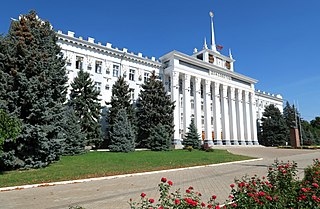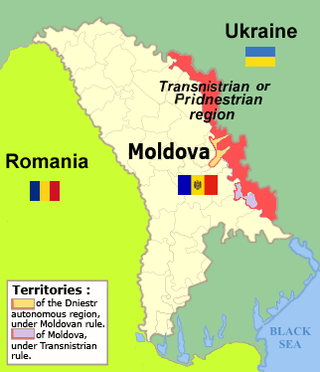In 1995, the main means of transportation in Moldova were railways and a highway system. The major railway junctions are Chișinău, Bender, Ungheni, Ocnița, Bălți, and Basarabeasca. Primary external rail links connect the republic's network with Odesa on the Black Sea and with the Romanian cities of Iași and Galați; they also lead northward into Ukraine. Highways link Moldova's main cities and provide the chief means of transportation within the country, but roads are in poor repair. The country's major airport is in Chișinău.

Tiraspol is the capital and largest city of Transnistria, a breakaway state of Moldova, where it is the third-largest city. The city is located on the eastern bank of the Dniester River. Tiraspol is a regional hub of culture, economy, tourism, and light industry, such as furniture and electrical goods production.

Transnistria, officially known as the Pridnestrovian Moldavian Republic and locally as Pridnestrovie, is a breakaway state internationally recognized as part of Moldova. It controls most of the narrow strip of land between the Dniester river and the Moldova–Ukraine border, as well as some land on the other side of the river's bank. Its capital and largest city is Tiraspol. Transnistria is officially designated by the Republic of Moldova as the Administrative-Territorial Units of the Left Bank of the Dniester or as Stînga Nistrului.

Bender or Bendery, also known as Tighina, is a city within the internationally recognized borders of Moldova under de facto control of the unrecognized Pridnestrovian Moldavian Republic (Transnistria) (PMR) since 1992. It is located on the western bank of the river Dniester in the Romanian historical region of Bessarabia.
Transnistria is a region in Eastern Europe that is under the effective control of the self-declared Pridnestrovian Moldavian Republic but is recognized by the international community as an administrative unit of Moldova, the Administrative-Territorial Units of the Left Bank of the Dniester.

The Transnistria War was an armed conflict that broke out on 2 November 1990 in Dubăsari between pro-Transnistria forces, including the Transnistrian Republican Guard, militia and neo-Cossack units, which were supported by elements of the Russian 14th Army, and pro-Moldovan forces, including Moldovan troops and police.

The Transnistria conflict is an ongoing frozen conflict between Moldova and the unrecognized state of Transnistria. Its most active phase was the Transnistria War. There have been several attempts to resolve the conflict, although none have been successful. The conflict may be considered as having started on 2 September 1990, when Transnistria made a formal sovereignty declaration from Moldova.

This is the history of Transnistria, officially the Pridnestrovian Moldavian Republic (PMR), an unrecognised breakaway state that is internationally recognised as part of Moldova. Transnistria controls most of the narrow strip of land between the Dniester river and the Moldovan–Ukrainian border, as well as some land on the other side of the river's bank.

Rail transport in Ukraine is a major transport mode in Ukraine. Most railway infrastructure in Ukraine is owned by the government of Ukraine through Ukrzaliznytsia, a joint-stock company which has a de facto country-wide monopoly on passenger and freight transport by rail.

The Russian Federation maintains an unknown number of soldiers in Transnistria, an unrecognized breakaway state internationally recognized as part of Moldova. This Russian military presence dates back to 1992, when the 14th Guards Army intervened in the Transnistria War in support of the Transnistrian separatist forces. Following the end of the war, which ended in a Russian-backed Transnistrian victory and in the de facto independence of the region, the Russian forces stayed in a purportedly peacekeeping mission and reorganized in 1995 into the Operational Group of Russian Forces (OGRF), currently guarding the Cobasna ammunition depot. Some other Russian soldiers also participate in the Joint Control Commission between Moldova, Russia and Transnistria since 1992.
The mass media of Transnistria, the breakaway territory within the borders of Moldova, features both state-owned or supported outlets and opposition media. Publications are in Russian, with a single newspaper in each of the other two official languages, Moldovan (Romanian), and Ukrainian.

The Pridnestrovian Moldavian Soviet Socialist Republic (PMSSR), also commonly known as Soviet Transnistria or simply as Transnistria, was created on the eastern periphery of the Moldavian Soviet Socialist Republic (MSSR) in 1990 by pro-Soviet separatists who hoped to remain within the Soviet Union when it became clear that the MSSR would achieve independence from the USSR and possibly unite with Romania. The PMSSR was never recognised as a Soviet republic by the authorities in either Moscow or Chișinău. In 1991, the Pridnestrovian Moldavian Republic succeeded the Pridnestrovian Moldavian Soviet Socialist Republic.

Official statistics of the Pridnestrovian Moldavian Republic, or Transnistria, show that 91 percent of the Transnistrian population adhere to Eastern Orthodox Christianity, with 4 percent adhering to the Catholic Church. Roman Catholics are mainly located in Northern Transnistria, a region with a notable Polish minority.

This timeline of events is a chronological list of incidents and other notable occurrences related to the War of Transnistria, including events leading up to the war.

Calea Ferată din Moldova is the sole railway operator in the Republic of Moldova, responsible for passenger and cargo transportation, as well as railway infrastructure maintenance within the country. The total length of the network managed by CFM is 1,232 kilometres (766 mi), of which 1,218 kilometres (757 mi) are 1,520 mm, and 14 kilometres (8.7 mi) are 1,435 mm. The entire network is single track and is not electrified. It borders the Romanian railway network, with a 1,520 mm /1,435 mm break-of-gauge in the west, and the Ukrainian one in the east.
The 14th Guards Combined Arms Army was a field army of the Red Army, the Soviet Ground Forces, and the Russian Ground Forces, active from 1956 to 1995. By the 1990s, according to sources within the 14th Army, the majority of its troops came from what would become the Pridnestrovian Moldavian Soviet Socialist Republic, with 51% of officers and 79% of draftees coming from this region.

Tiraspol railway station is a railway station in the city of Tiraspol, capital of the de facto state of Transnistria, recognised internationally as part of Moldova. It has both passenger and freight facilities, including a capacity for border control by the Transnistrian authorities.

Currently, there are three defined types of public roads in the Republic of Moldova:
The M4 highway is a road in Transnistria, Moldova. It runs from the south to the north, being 178 km (111 mi) long, and links the Transnistrian capital of Tiraspol with Rîbnița via Dubăsari, reaching the border with Ukraine at Hristovaia, where it merges with the Ukrainian local road T0225. Running along the left bank of the Dniester for most of its length, it is the only road with magistral road status that does not start nor pass through the Moldovan capital of Chișinău.

The M5 highway, during Soviet period referred to as the M14, is the longest road in Moldova, with a length of 370 km (230 mi) running from the north to the south-east. Having national road status, it is also one of the most important routes as it provides access to the three largest cities of Moldova within its internationally recognized borders: Bălți, Chișinău and Tiraspol. It forms part of the European routes E58, E581 and E583 of the International E-road network.






















